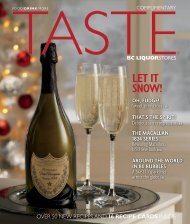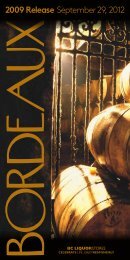You also want an ePaper? Increase the reach of your titles
YUMPU automatically turns print PDFs into web optimized ePapers that Google loves.
BERRIES<br />
sTRAwBERRIEs: Peak season for these fruity<br />
favourites is June to July. Choose the ones<br />
with a uniform, deep red colour. If the<br />
tops of the berries are green or white – pass<br />
them by. They were picked too soon and<br />
won’t ripen now. Keep strawberries in a<br />
single layer in the fridge to avoid bruising.<br />
RAsPBERRIEs: Peak raspberry season is June<br />
to July. Buy firm, small to medium-sized<br />
berries free from discolouration or bruises.<br />
Raspberries are very delicate and don’t last<br />
long after picking. As with strawberries,<br />
store in the fridge in a single layer and wash<br />
just prior to using.<br />
GOOsEBERRIEs: Peak season is July.<br />
Gooseberries are very tart making them<br />
great for jams and jellies. Choose firm<br />
berries with a slight yield when pressed.<br />
BLACKCuRRANTs ANd REdCuRRANTs:<br />
Peak season is July to August for blackcurrants;<br />
June to August for redcurrants. Too<br />
astringent to be eaten out of your hand but<br />
their high pectin content makes them ideal<br />
for jams and jellies. Choose clusters that are<br />
firm, plump and shiny.<br />
BLACKBERRIEs: Peak season is August to<br />
September. A ripe blackberry should be<br />
extremely plump and taste sweet but with<br />
a puckery finish. Avoid the red berries.<br />
This is a sign that they’ve been picked too<br />
early. Similar to blackberries are tayberries,<br />
boysenberries, loganberries and marionberries.<br />
BLuEBERRIEs: Peak season is August to<br />
September. Choose plump berries and note<br />
that wild blueberries are much smaller than<br />
their farm-raised cousins. It’s fine if they have<br />
snowy powder bloom – it indicates freshness.<br />
STONE FRUIT<br />
APRICOTs: Peak season is June to July.<br />
Choose apricots that are plump and juicy<br />
and a uniform gold-orange colour. Avoid<br />
mushy or pale yellow fruit.<br />
CHERRIEs: Peak season is July to August.<br />
Sweet Bing cherries are dark burgundy and<br />
very juicy. Their golden-blush cousins, the<br />
Rainier, are very meaty and sweet too. Sour<br />
cherries are dusky red in colour and good for<br />
cooking. It’s best to buy plump cherries with<br />
intact stems and a strong, fragrant aroma.<br />
PEACHEs ANd NECTARINEs: Peak season is<br />
mid July to September for peaches, August to<br />
September for nectarines. A ripe fresh peach<br />
or nectarine should yield to gentle pressure<br />
when squeezed and have a heady perfume.<br />
Avoid fruit that is hard as it will soften but not<br />
ripen with flavour once picked. Keep in the<br />
refrigerator up to seven days. Bring to room<br />
temperature before eating.<br />
EASY FREEZE<br />
The quickest and easiest way to preserve<br />
berries and stone fruit is by freezing.<br />
However, once frozen, fruit is best used to<br />
make juices, sauces, purées or baked desserts<br />
since it loses its shape and considerable<br />
texture when defrosted. Freeze fruit that is<br />
for recipes, please see page 116<br />
ripe – not too soft and mushy or too firm.<br />
The best way to freeze berries is called the<br />
“dry freeze” method. Wash berries in cold<br />
water to tighten up the skin, then pat dry<br />
with paper towels. Spread out in a single layer<br />
on a baking sheet until completely frozen,<br />
then portion out and seal in freezer bags.<br />
To freeze stone fruits such as peaches,<br />
nectarine and apricots, remove pits, then<br />
cut fruit into halves or wedges. To preserve<br />
colour, quickly blanch in boiling water,<br />
then refresh in cold water and pat dry. To<br />
prevent browning, toss with a little lemon<br />
juice. As with berries, freeze in a single<br />
layer, then portion and seal in freezer bags.<br />
a feW freeziNg tips<br />
1) Label bags with produce names<br />
and dates.<br />
2) use within 8 to 12 months.<br />
3) Don’t overfill bags.<br />
4) Don’t defrost frozen fruit before<br />
using. Cook from frozen.<br />
5) Prevent freezer burn by<br />
removing as much air as possible<br />
from freezer bags. if you don’t<br />
have an electric vacuum sealer,<br />
close freezer bag leaving space at<br />
one end to insert a straw. insert<br />
the straw in gap and suck as<br />
much air out as possible. remove<br />
the straw and completely seal<br />
the freezer bag.<br />
TASTE 21





